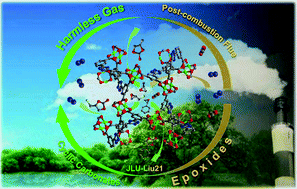Highly efficient synergistic CO2 conversion with epoxide using copper polyhedron-based MOFs with Lewis acid and base sites †
Abstract
To systematically study the effect of Lewis acid sites (LASs) and Lewis base sites (LBSs) in MOF materials for the CO2 cycloaddition reaction, four isomorphous copper polyhedron-based MOFs (Cu-PMOFs), JLU-Liu20, JLU-Liu21, JLU-Liu22 and JLU-Liu46 with different amounts of LASs and LBSs were selected to investigate their CO2 fixation catalytic performance. It is commendable that the catalytic capabilities of the four Cu-PMOFs exceed that of most reported MOF-based catalysts. Benefitting from the abundant LASs and appropriate alkaline strength of LBSs, JLU-Liu21 shows the best catalytic performance for the cycloaddition of CO2 with epoxides among the four Cu-PMOFs and the yield of catalyzing propylene oxide can reach up to 98% under 1 bar CO2. It is worth mentioning that even under post-combustion flue atmosphere (15% CO2 and 85% N2), its yield can reach up to 92%, which surpasses most other MOF catalysts under similar reaction conditions. The 5-time recycling circulation experiments also indicated JLU-Liu21's excellent recyclability and catalytic stability, which is highly desirable in decontaminating noxious gas and meets industrial requirements for sustainability.



 Please wait while we load your content...
Please wait while we load your content...